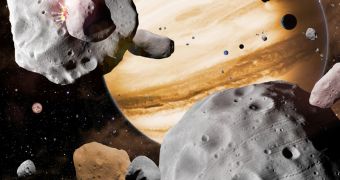According to the conclusions of a new study by experts at the Harvard-Smithsonian Center for Astrophysics (CfA), it would appear that the early history of the solar system was more tumultuous than first thought. This hypothesis is based on a study of the Inner Asteroid Belt (IAB).
The CfA team, led by Hubble postdoctoral fellow Francesca DeMeo, determined that the eight planets in our solar system had a very rich and violent history. Until recently, astronomers thought that all planets orbit in the same position with respect to the Sun as they did when they first formed.
However, emerging research suggests that tremendous orbital variability existed for these worlds, and especially for gas and ice giant (Jupiter, Saturn, Uranus and Neptune), back when the solar system was still in its infancy. Jupiter, for example, is thought to have once occupied the orbit of Mars.
The new study reveals that all planets moved both closer and farther away from the Sun from their current positions. The IAB basically keeps a record of these motions. Astronomers have determined that the formation contains objects from all over the solar system.
The belt lies between the orbits of Mars and Jupiter, and features millions upon millions of asteroids. Scientists first thought that these objects were left behind following the formation of the eight planets, since they were not able to accumulate sufficient mass to form fully-fledged worlds.
The new research argues that gravitational influences from the largest planets in the solar system may have destroyed the belt several times, around 4 billion years ago. When Jupiter migrated closer to the Sun, for example, it cast away all asteroids, leaving just a tenth of one percent of the initial population.
“We found that the giant planets shook up the asteroids like flakes in a snow globe,” says DeMeo. She is also the lead author of a new paper detailing the findings, which was published in the January 30 issue of the top scientific journal Nature.
After the large objects in the solar system began settling into their final orbits, objects located as close to the Sun as Mercury, and as far away as Neptune, began migrating towards the current location of the IAB. “The asteroid belt is a melting pot of objects arriving from diverse locations and backgrounds,” DeMeo explains.
This study is important because many of the asteroids in the inner belt contain large amounts of water ice. A theory suggests that much of Earth's waters were brought here on comets and asteroids during the Late Heavy Bombardment, which lasted from 4.2 to 3.8 billion years ago.
If that is indeed the case, then it is highly possible that life outside our planet may not be as common as recent studies suggest. In order to accumulate sufficient water to allow for the development of basic lifeforms, alien worlds would have to develop in star systems similar to the solar system.

 14 DAY TRIAL //
14 DAY TRIAL //